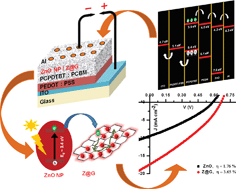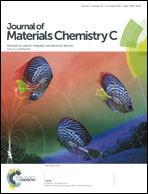ZnO anchored graphene hydrophobic nanocomposite-based bulk heterojunction solar cells showing enhanced short-circuit current†
Abstract
Hydrophobic and surfactant-free ZnO nanoparticles and ZnO decorated graphene nanocomposite (Z@G) with narrow and uniform size distribution were synthesized by a time-efficient microwave-assisted hydrothermal reaction that can be used specifically for application in hybrid photovoltaics. The synthesized ZnO nanoparticles and Z@G nanocomposite showed stable and clear dispersion in chloroform and methanol (with volume ratio of 9 : 1) and chloroform and ethanol (volume ratio 9 : 1). Being hydrophobic, these inorganic samples blend very well with organic polymer solution in chlorobenzene, which is a prerequisite to cast smooth and undisrupted film for hybrid solar cell application. The introduction of these hydrophobic nanoparticles into PCPDTBT:PCBM-based bulk-heterojunction polymer solar cells resulted in significant improvement in solar cell J–V characteristics with enhancement in open circuit voltage (VOC), short circuit current density (JSC) and thereby overall improvement in cell efficiency. With the optimization of the weight ratio of polymer, fullerene and synthesized ZnO nanoparticles/Z@G nanocomposite, the power conversion efficiencies 1.76% and 3.65% were achieved.


 Please wait while we load your content...
Please wait while we load your content...